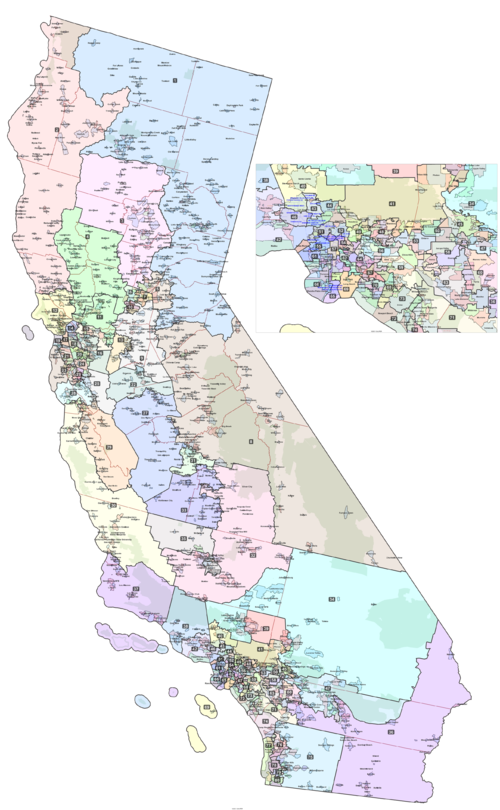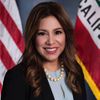California State Senate District 15
 From Ballotpedia - Reading time: 8 min
From Ballotpedia - Reading time: 8 min

| Census Topic | Value |
|---|---|
| Population | 969,001 |
| Gender |
50.1% Male 49.9% Female |
| Race |
31.8% White 2.5% Black 36.6% Asian 1.3% Native American 0.3% Pacific Islander |
| Ethnicity | 28.5% Hispanic |
| Median household income | $115,584 |
| High school graduation rate | 86.3% |
| College graduation rate | 47.6% |
California State Senate District 15 is represented by Dave Cortese (D).
As of the 2020 Census, California state senators represented an average of 988,455 residents. After the 2010 Census, each member represented 931,348 residents.
About the office[edit]
Members of the California State Senate serve four-year terms with term limits.[1] The terms of the senators are staggered so that half the membership is elected every two years. The senators representing odd-numbered districts are elected in years evenly divisible by four. The senators from even-numbered districts are elected in the intervening even-numbered years. California legislators assume office the first Monday in the December following their election.
Qualifications[edit]
According to Article IV of the California Constitution, a candidate for the Senate must be:
- a citizen of the U.S.;
- a state resident for at least three years;
- a resident of his or her legislative district for at least one year; and
- a registered voter in that district by the time nomination papers are filed.[2]
Salaries[edit]
- See also: Comparison of state legislative salaries
| State legislators | |
|---|---|
| Salary | Per diem |
| $114,877/year | $211/day |
Term limits[edit]
- See also: State legislatures with term limits
Since the passage of Prop 28 in 2012, legislators first elected on or after November 6, 2012, are limited to a maximum of 12 years. Prop 140, passed in 1990, affects any members elected prior to November 6, 2012, and limits them to a maximum of two four-year terms (eight years total).[3]
Vacancies[edit]
If there is a vacancy in the California State Legislature, the governor must call for a special election. The election must be called by the governor within 14 days of the vacancy. No special election can be held if the vacancy happens in an election year and the nominating deadline passes.[4]
![]() See sources: California Elec. Code, § 10700 and California Cons. Art. IV, § 2
See sources: California Elec. Code, § 10700 and California Cons. Art. IV, § 2
District map[edit]
The map below shows this district's current boundaries, not those enacted as part of the 2020 redistricting cycle.
Redistricting[edit]
2020-2021[edit]
The California Citizens Redistricting Commission voted 14-0 in favor of a new state Assembly and Senate district maps on December 20, 2021, and delivered those maps to the secretary of state on December 27, 2021.[5][6] These maps take effect for California's 2022 state legislative elections.
State Assembly map[edit]
Click here to view a larger version of this map.
State Senate map[edit]
Click here to view a larger version of this map.
Reactions[edit]
Following the 2020 elections, Democrats held supermajorities in both legislative chambers. In the state Assembly, the party held 60 of the 80 seats with Republicans holding 19 and an independent holding one. In the state Senate, Democrats held 31 of the 40 seats with Republicans holding the remaining nine. CalMatters' Sameea Kamal wrote, "Democrats' grip of the Assembly could tighten," under the new maps with 63 districts having a strong Democratic lean.[7] Kamal added that "the Democratic majority in the state Senate might shrink," with three districts becoming more Republican and one becoming more Democratic in terms of voter registration.[7] Demographically, the Associated Press' Don Thompson wrote that the new maps created 22 Assembly districts and 11 Senate districts with a Latino citizen voting age population greater than 50%, an increase of six and four such districts compared to previous maps, respectively.[8]
How does redistricting in California work? In California, a non-politician commission draws both congressional and state legislative district lines. Established in 2008 by ballot initiative, the commission comprises 14 members: five Democrats, five Republicans, and four belonging to neither party. A panel of state auditors selects the pool of nominees from which the commissioners are appointed. This pool comprises 20 Democrats, 20 Republicans, and 20 belonging to neither party. The majority and minority leaders of both chambers of the state legislature may each remove two members from each of the aforementioned groups. The first eight commission members are selected at random from the remaining nominees. These first eight comprise three Democrats, three Republicans, and two belonging to neither party. The first eight commissioners appoint the remaining six, which must include two Democrats, two Republicans, and two belonging to neither party.[9]
Commissioners must meet the following requirements in order to serve:[9]
- Members must have voted in at least two of the last three statewide elections.
- Members cannot have switched party affiliation for at least five years.
- "Neither commissioners nor immediate family may have been, within 10 years of appointment, a candidate for federal or state office or member of a party central committee; an officer, employee, or paid consultant to a federal or state candidate or party; a registered lobbyist or paid legislative staff; or a donor of more than $2,000 to an elected candidate."
- Members cannot be "staff, consultants or contractors for state or federal government" while serving as commissioners. The same prohibition applies to the family of commission members.
In order to approve a redistricting plan, nine of the commission's 14 members must vote for it. These nine must include three Democrats, three Republicans, and three belonging to neither party. Maps drawn by the commission may be overturned by public referendum. In the event that a map is overturned by the public, the California Supreme Court must appoint a group to draw a new map.[9]
The California Constitution requires that districts be contiguous. Further, the state constitution mandates that "to the extent possible, [districts] must ... preserve the geographic integrity of cities, counties, neighborhoods and communities of interest." Districts must also "encourage compactness." State Senate and Assembly districts should be nested within each other where possible.[9]
Elections[edit]
2020[edit]
- See also: California State Senate elections, 2020
General election for California State Senate District 15
Dave Cortese defeated Ann Ravel in the general election for California State Senate District 15 on November 3, 2020.
Candidate |
% |
Votes |
||
| ✔ |
|
Dave Cortese (D) 
|
54.8
|
212,207 |
|
|
Ann Ravel (D) |
45.2
|
175,203 | |
| Total votes: 387,410 | ||||
 = candidate completed the Ballotpedia Candidate Connection survey. = candidate completed the Ballotpedia Candidate Connection survey. | ||||
Do you want a spreadsheet of this type of data? Contact our sales team. |
||||
Nonpartisan primary for California State Senate District 15
The following candidates ran in the primary for California State Senate District 15 on March 3, 2020.
Candidate |
% |
Votes |
||
| ✔ |
|
Dave Cortese (D) 
|
33.9
|
79,507 |
| ✔ |
|
Ann Ravel (D) |
22.1
|
51,752 |
|
|
Nora Campos (D) |
16.9
|
39,683 | |
|
|
Robert Howell (R) |
10.2
|
23,840 | |
|
|
Johnny Khamis (Independent) |
10.1
|
23,747 | |
|
|
Ken Del Valle (R) |
6.1
|
14,280 | |
|
|
Tim Gildersleeve (Independent) |
0.7
|
1,635 | |
| Total votes: 234,444 | ||||
 = candidate completed the Ballotpedia Candidate Connection survey. = candidate completed the Ballotpedia Candidate Connection survey. | ||||
Do you want a spreadsheet of this type of data? Contact our sales team. |
||||
Watch the Candidate Conversation for this race!
2016[edit]
- See also: California State Senate elections, 2016
Elections for the California State Senate took place in 2016. The primary election was held on June 7, 2016, and the general election was held on November 8, 2016. The candidate filing deadline was February 25, 2016, for candidates filing with signatures. The deadline for candidates using a filing fee to qualify was March 11, 2016.[10]
Incumbent James Beall Jr. defeated Nora Campos in the California State Senate District 15 general election.[11][12]
| California State Senate, District 15 General Election, 2016 | ||||
|---|---|---|---|---|
| Party | Candidate | Vote % | Votes | |
| Democratic | 62.54% | 196,089 | ||
| Democratic | Nora Campos | 37.46% | 117,442 | |
| Total Votes | 313,531 | |||
| Source: California Secretary of State | ||||
Incumbent James Beall Jr. and Nora Campos defeated Chuck Page and Anthony Macias in the California State Senate District 15 Blanket primary.[13][14]
| California State Senate, District 15 Blanket Primary, 2016 | ||||
|---|---|---|---|---|
| Party | Candidate | Vote % | Votes | |
| Democratic | 49.44% | 97,948 | ||
| Democratic | 26.88% | 53,250 | ||
| Republican | Chuck Page | 20.58% | 40,783 | |
| Republican | Anthony Macias | 3.10% | 6,147 | |
| Total Votes | 198,128 | |||
2012[edit]
- See also: California State Senate elections, 2012
Elections for the office of California State Senate consisted of a primary election on June 5, 2012, and a general election on November 6, 2012. The signature filing deadline for candidates wishing to run in this election was March 9, 2012. Democrats James Beall Jr. and Joe Coto ran unopposed in the June 5 blanket primary. Beall went on to defeat Coto in the general election.[15] [16]
| California State Senate, District 15, General Election, 2012 | ||||
|---|---|---|---|---|
| Party | Candidate | Vote % | Votes | |
| Democratic | 56.7% | 160,451 | ||
| Democratic | Joe Coto | 43.3% | 122,345 | |
| Total Votes | 282,796 | |||
Campaign contributions[edit]
From 2000 to 2016, candidates for California State Senate District 15 raised a total of $12,003,670. Candidates who raised money in contributions earned $631,772 on average. All figures come from Follow the Money
| Campaign contributions, California State Senate District 15 | |||
|---|---|---|---|
| Year | Amount | Candidates | Average |
| 2016 | $2,320,306 | 4 | $580,077 |
| 2012 | $1,082,928 | 2 | $541,464 |
| 2010 | $72,626 | 1 | $72,626 |
| 2008 | $1,767,904 | 2 | $883,952 |
| 2006 | $307,643 | 1 | $307,643 |
| 2004 | $5,806,366 | 3 | $1,935,455 |
| 2002 | $142,315 | 1 | $142,315 |
| 2000 | $503,582 | 5 | $100,716 |
| Total | $12,003,670 | 19 | $631,772 |
See also[edit]
- California State Legislature
- California State Senate
- California State Assembly
- California state legislative districts
External links[edit]
Footnotes[edit]
- ↑ California State Constitution, accessed December 16, 2013
- ↑ California Legislature, "Article IV Legislative," accessed February 9, 2021
- ↑ California Legislative Information, "Article IV Legislative (Sec. 1 - Sec. 28)," accessed February 9, 2021
- ↑ California Legislative Information, "California Code," accessed February 9, 2021 (Statute, 1773-California Government Code)
- ↑ Politico, "California’s new congressional map boosts Democrats," Dec. 21, 2021
- ↑ Lake County News, "California Citizens Redistricting Commission delivers maps to California Secretary of State," Dec. 28, 2021
- ↑ 7.0 7.1 capradio, "California redistricting: What to know about the final maps," Dec. 21, 2021
- ↑ KCRA, "California redistricting commission defends new state maps," Dec. 27, 2021
- ↑ 9.0 9.1 9.2 9.3 All About Redistricting, "California," accessed April 21, 2015
- ↑ California Secretary of State, "Key Dates and Deadlines," accessed April 18, 2017
- ↑ California Secretary of State, "Certified List of Candidates for the November 8, 2016, General Election," accessed September 7, 2016
- ↑ California Secretary of State, "2016 General Election results," accessed December 23, 2016
- ↑ California Secretary of State, "Certified List of Candidates for Voter-Nominated Offices," accessed April 4, 2016
- ↑ California Secretary of State, "Statement of Vote," accessed August 22, 2016
- ↑ " California Secretary of State, "2012 General Election," November 7, 2013 (dead link)
- ↑ California Secretary of State, "2012 General Primary,” November 7, 2013
 KSF
KSF







